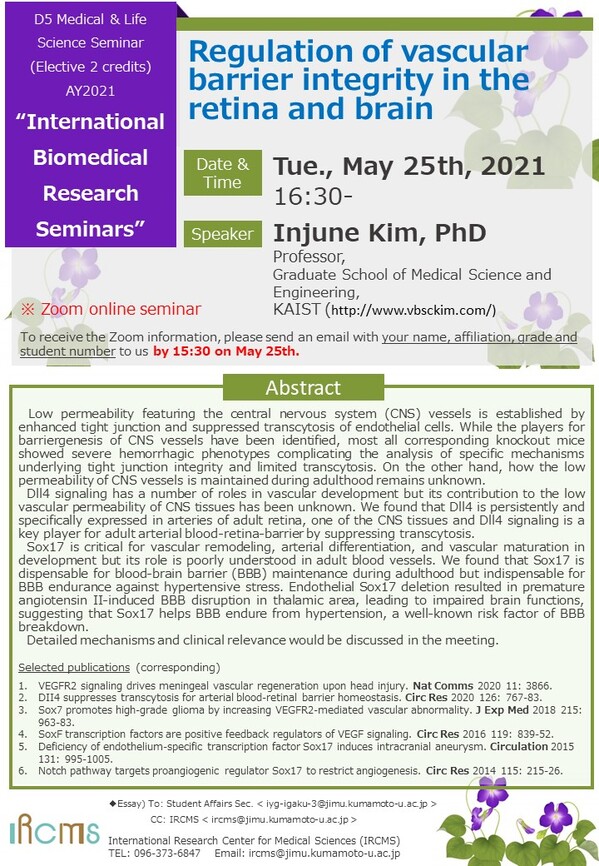- HOME
- News & Events
- [May 25] D5 Medical & Life Science Seminar-Dr. Injune Kim
News & Events
[May 25] D5 Medical & Life Science Seminar-Dr. Injune Kim
May 12 2021
The "D5 Medical & Life Science Seminar" course will be offered by International Research Center for Medical Sciences (IRCMS). It will run from April 2021 to March 2022, with lectures given by scientists who are affiliated with IRCMS or in collaboration with researchers at IRCMS. The lectures will be given once a month, in English, and by leading scientists in the relevant research field. Students will be taught: 1) how normal physiological functions are maintained in the human body; 2) how these systems become abnormal under certain pathophysiologic conditions; 3) why stem cells are important in animal development and homeostasis; 4) how stem cell-based approaches can help us understand disease mechanisms and find potential cure for diseases related to stem cell malfunction (e.g., cancer, aging).
Date : May 25, 2021 (Tuesday)
Time : 16:30 -
* Zoom online seminar
|
To receive the meeting ID / Password, please send an email to |
Speaker : Injune Kim, PhD
Professor,
Graduate School of Medical Science and Engineering,
Korea Advanced Institute of Science and Technology (KAIST)
Title : Regulation of vascular barrier integrity in the retina and brain
Abstract :
Low permeability featuring the central nervous system (CNS) vessels is established by enhanced tight junction and suppressed transcytosis of endothelial cells. While the players for barriergenesis of CNS vessels have been identified, most all corresponding knockout mice showed severe hemorrhagic phenotypes complicating the analysis of specific mechanisms underlying tight junction integrity and limited transcytosis. On the other hand, how the low permeability of CNS vessels is maintained during adulthood remains unknown.
Dll4 signaling has a number of roles in vascular development but its contribution to the low vascular permeability of CNS tissues has been unknown. We found that Dll4 is persistently and specifically expressed in arteries of adult retina, one of the CNS tissues and Dll4 signaling is a key player for adult arterial blood-retina-barrier by suppressing transcytosis.
Sox17 is critical for vascular remodeling, arterial differentiation, and vascular maturation in development but its role is poorly understood in adult blood vessels. We found that Sox17 is dispensable for blood-brain barrier (BBB) maintenance during adulthood but indispensable for BBB endurance against hypertensive stress. Endothelial Sox17 deletion resulted in premature angiotensin II-induced BBB disruption in thalamic area, leading to impaired brain functions, suggesting that Sox17 helps BBB endure from hypertension, a well-known risk factor of BBB breakdown.
Detailed mechanisms and clinical relevance would be discussed in the meeting.
Selected publications (corresponding):
- VEGFR2 signaling drives meningeal vascular regeneration upon head injury. Nat Comms 2020 11: 3866.
- DII4 suppresses transcytosis for arterial blood-retinal barrier homeostasis. Circ Res 2020 126: 767-83.
- Sox7 promotes high-grade glioma by increasing VEGFR2-mediated vascular abnormality. J Exp Med 2018 215: 963-83.
- SoxF transcription factors are positive feedback regulators of VEGF signaling. Circ Res 2016 119: 839-52.
- Deficiency of endothelium-specific transcription factor Sox17 induces intracranial aneurysm. Circulation 2015 131: 995-1005.
- Notch pathway targets proangiogenic regulator Sox17 to restrict angiogenesis. Circ Res 2014 115: 215-26.
Flyer: (Click for a larger image)

